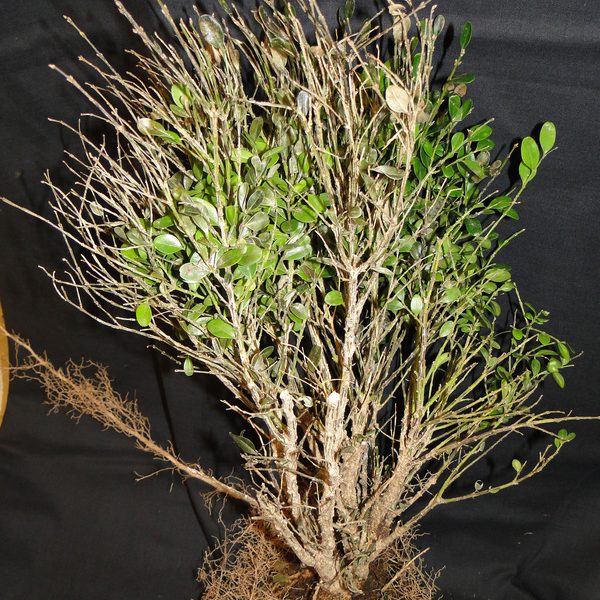

Boxwood has a long history in our landscapes. It goes back to the days of our early settlers, and before that, back centuries to English and French gardens.
This is a shrub that stands on its own as a deer-proof specimen, a marker, divider, classical parterre and a hedgerow plant. It grows from 6 inches tall to 6 feet tall, dividing and partitioning gardens from the ornate to the simple.
Our dependence and usage of boxwood may be changing, and very, very quickly.
Now, for all of its attributes the boxwood has had its problems. If the wrong variety is used in the wrong climate zone, the plant can be marginal. If the root system encounters soil issues, portions of the plant can show the symptoms or the entire shrub may fail. And then there’s the boxwood leaf miner—a pesky but controllable insect that spends a portion of its life injecting eggs into the leaves, which then develop into maggot-like feeders eating from the inside out, leaving the leaves mined and colorless.
But now there are bigger problems on the horizon for the boxwood.
In the 1990s, a fungal disease was described on boxwood in the United Kingdom. While it was noted, not too much attention was paid. Then in 2002 the disease was discovered in New Zealand. It was at that time that boxwood blight, or box blight, was formally identified for the first time.
Though boxwood blight was discovered in Europe, the scope of the disease and the potential for worldwide infection didn’t become an issue. That was not until it was discovered recently in the United States. And this year it’s expected to hit Long Island, if it hasn’t already.
Ladies and gentlemen, meet
cylindrocladium pseudonaviculatum
.
Sorry, the news gets worse. Usually when a disease strikes a plant community we find some members of the community that show an immunity or resistance to the disease; then those varieties become the ones that are favored for use, be it in vegetables, fruits, flowers or landscape plants. Unfortunately, this does not seem to be the case with box blight. According to the most recent research, no boxwood species that has been purposefully infected with the disease has shown a demonstrated immunity.
The manner in which boxwood is grown in nurseries, with plants nearly touching plants, or in the home landscape, where it’s often used for hedging or partitioning, can result in the disease’s rapid spread by human or physical contact. It’s known that the disease can spread on splashing water and that it can travel short distances by being airborne. The pathogen can remain on leaves that fall to the ground and remain virulent for as long as six years (no, winter won’t kill it), so garden and nursery sanitation is a big issue.
The blight affects the leaves, stems and shoots but does not appear to infect the roots. But it has been shown that repeated infections of the foliage can weaken and kill the roots if the shrub defoliates repeatedly.
Boxwood blight is most likely to kill the newly planted and younger shrubs. It is not likely that it will sweep through your garden or landscape unless you have planted new boxwoods within the past one to two years.
Some fungicides are being used to control the blight but the reality is that so far no chemical treatment is known to stop the infection. To the contrary, several chemicals are being used that simply mask the symptoms while the plant remains an active breeding ground and reservoir for infection.
This all brings us to some very serious practical and ethical issues. Thousands of boxwoods are probably sold on the East End every year. As there is no test that can easily and quickly be done to determine if a boxwood plant is infected, local nurseries and retailers that have boxwood in stock have to consider the long- and short-term consequences of selling plants that may be infected, thus spreading the infection to an unsuspecting customer and their landscape.
Should a retailer offer you some verbal or even written assurance that the plants being sold are blight free? The offer is a hollow one because the two plant pathologists that I’ve spoken with who are working with this problem say that such a guarantee isn’t possible at the present time.
And what about the grower, the nursery that has rows and rows or pots and pots of boxwood ready to be shipped to market? What should these places do? Again, at this point in time there is no sure way to certify that any grower’s plants are blight free.
Should the growers and sellers be taking the chance of spreading the disease? Since we know that treated plants may be asymptomatic but still highly contagious—with the visible clues of an infection only being masked by chemicals—should these businesses be betting against infecting a retail nursery, a landscape job or a homeowner’s garden?
And what should you do about the blight? Researchers say the simple answer is not to buy boxwoods right now. The suggestion is to wait at least a year and hopefully by then a quick test can be designed that will allow for some type of certification so you know you are buying blight-free plants. It has even been suggested that if you’ve got healthy boxwood on your property, you may want to learn how to take cuttings and propagate your own new plants as the blight problem may turn out to be very long-lived and persistent. But remember, it’s the common wisdom that if you haven’t purchased boxwoods in the past year to 18 months, the plants on your property are pretty safe.
All this leads to the last question. What do you do if you planted boxwood in your garden or on your property recently? You need to keep a good eye on these plants and know what symptoms to watch for.
A simple yellowing of the leaves is not enough to cause panic. On the other hand, newly planted boxwood that starts to suddenly defoliate is reason for concern. In that case, you should gather some of the leaves and stems and put them in a plastic bag, then get them to the Cornell Cooperative Extension office in Riverhead for a diagnosis.
In the interim, carefully clean up all the fallen leaves then put them in a sealed plastic bag. Put the bag in the trash, don’t compost the leaves.
The nursery community, retailers and researchers know how important this plant is and the dangers that are lurking. Scientists are working hard, and as quickly as they can, to see if there’s a reliable treatment, reliable testing and any resistant varieties. It’s going to take time. And until there’s some kind of resolution, boxwood should not be in your planting plans.
If you need more information, I’d be happy to send you some links that have background and current thinking on the problem. The links also include a good selection of pictures that will help you if you think you’ve got box blight. In the meantime, read up on boxwood alternatives. And keep growing.
 More Posts from Andrew Messinger
More Posts from Andrew Messinger